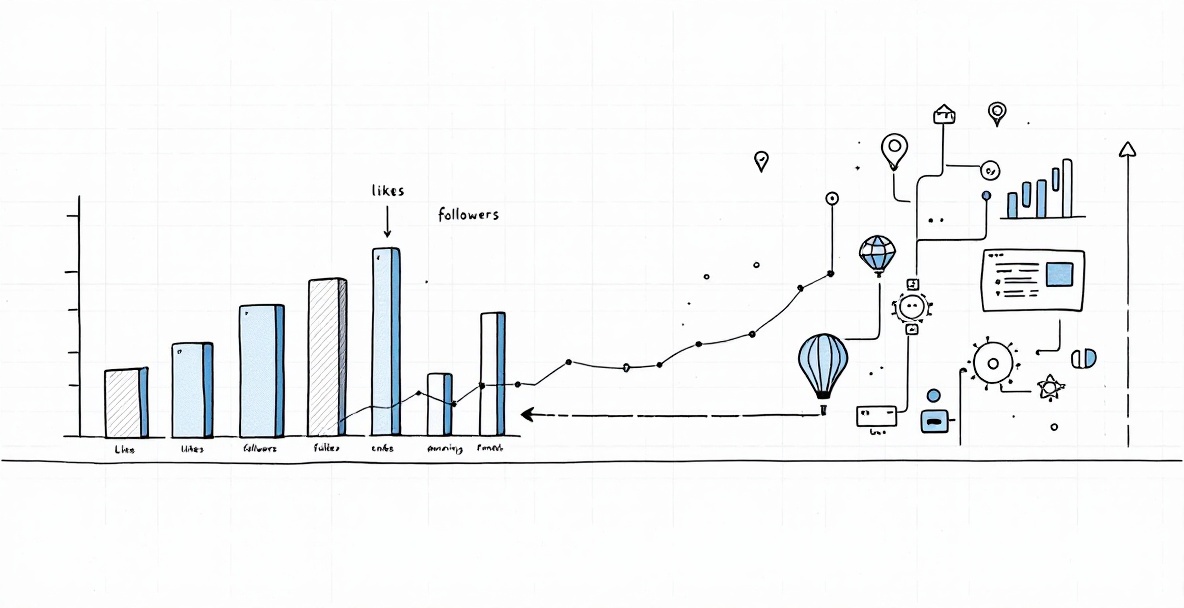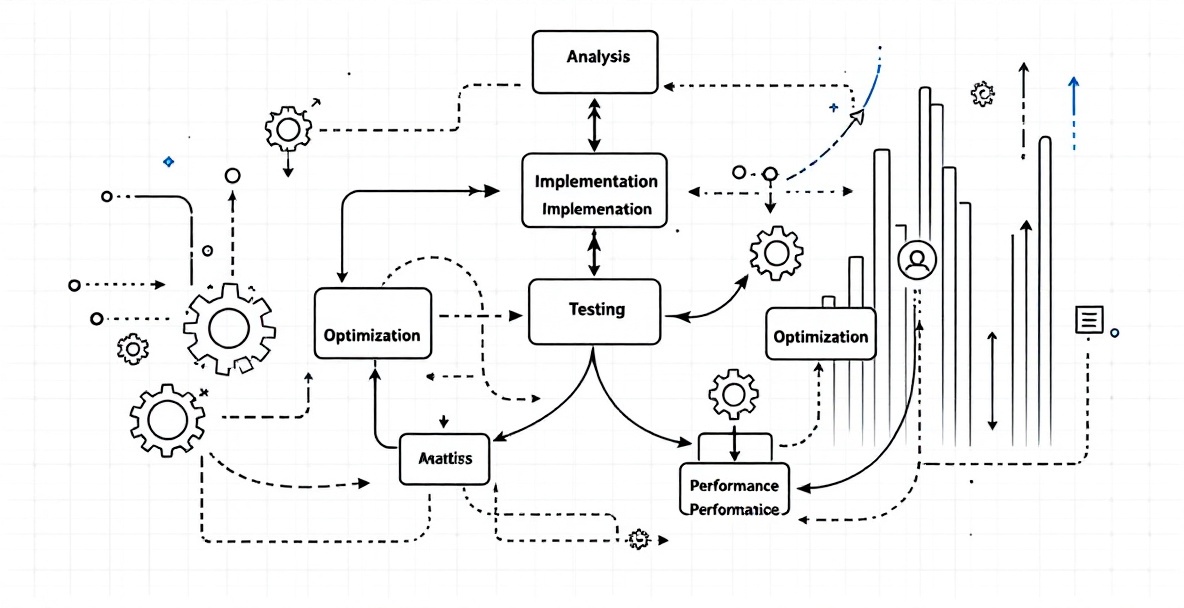In a digital ecosystem where every like, share, and comment can influence brand perception, marketers have increasingly turned to social media analytics to gauge performance. However, the traditional focus on followers, likes, and surface-level engagement metrics often creates a false sense of success while failing to capture true business impact. Today's most successful digital marketing strategists understand that effective social analytics must connect directly to business outcomes and provide actionable intelligence beyond simple vanity metrics.
The Evolution Beyond Vanity Metrics in Social Media Analytics

The social media measurement landscape has undergone a dramatic transformation in recent years. What began as simple counting mechanisms for followers and basic engagement has evolved into sophisticated analytical frameworks that can directly tie social media activities to business results. This evolution represents a critical shift in how organizations approach social media strategy and measurement.
The Problem with Traditional Social Media Metrics
Traditional social media metrics—followers, likes, shares, and surface-level engagement rates—have dominated marketing dashboards for years. While these metrics provide easily digestible numbers that create the appearance of success, they often fail to correlate with meaningful business outcomes. A study by the Content Marketing Institute revealed that 58% of marketers struggle to connect social media metrics to actual business results, despite maintaining active social presences.
These vanity metrics present several significant problems for marketing teams. First, they create false positives—situations where apparent social success doesn't translate to revenue or business growth. Second, they encourage tactics focused on generating attention rather than value. Finally, they often lead to misallocated resources as teams chase metrics that look impressive but deliver minimal impact to the bottom line.
The Rise of Strategic Social Analytics
The shift toward strategic social analytics represents a fundamental change in approach. Rather than asking "How many people saw our content?" strategic analytics poses more valuable questions: "Did our content reach the right audience?" "Did it move them closer to purchase?" and "How did it contribute to our overall marketing objectives?"
This transformation is being driven by several factors. Advanced attribution models now allow marketers to trace the customer journey from social touchpoints through to conversion. Machine learning algorithms can identify patterns in engagement data that humans might miss. Additionally, the integration of social data with other marketing systems provides a more holistic view of performance across channels.
At SEO Tuts, we've observed this shift firsthand, noting that clients who implement strategic social analytics frameworks typically see a 2-3x improvement in ROI from their social media investments compared to those still relying primarily on vanity metrics.
Core Components of Advanced Social Media Analytics

Truly effective social media analytics combines multiple dimensions of measurement to create a comprehensive understanding of performance. These components work together to provide insights that drive strategy and improve outcomes.
Audience Intelligence and Segmentation Tools
Modern analytics tools have evolved far beyond basic demographic data to provide rich insights into audience behaviors, preferences, and patterns. Audience intelligence platforms now offer detailed psychographic profiling, interest mapping, and behavioral segmentation capabilities that allow marketers to understand not just who their audience is, but what motivates them.
These tools enable organizations to identify distinct segments within their broader audience and tailor content specifically for each group. For example, a software company might discover through advanced audience analysis that their Twitter followers include both technical decision-makers and business leaders—each requiring different messaging approaches and content types.
Effective audience intelligence tools also provide competitive intelligence, allowing brands to understand not just their own audience but also the composition and engagement patterns of competitors' audiences. This competitive context helps marketers identify audience gaps and opportunities for differentiation.
Content Performance Analytics
Content performance analytics has matured from basic engagement metrics to sophisticated impact measurement frameworks. Advanced analytics tools now measure content effectiveness across multiple dimensions: attention metrics (time spent, scroll depth), engagement quality (sentiment analysis, conversation depth), conversion impact, and cross-platform performance.
These tools enable marketers to understand which content formats, topics, and distribution strategies drive meaningful outcomes. By analyzing patterns across high-performing content, organizations can develop content strategies that consistently deliver results rather than occasional viral hits.
The most sophisticated content analytics platforms incorporate machine learning to identify patterns and provide predictive insights about which content types are likely to perform well with specific audience segments. This predictive capability allows for more efficient resource allocation and higher content ROI.
Conversion Tracking and Attribution
Perhaps the most critical evolution in social media analytics is the development of robust conversion tracking and attribution systems. These tools connect social media activities directly to business outcomes by tracking user journeys from initial social touchpoints through to conversion events.
Advanced attribution models have moved beyond simple last-click attribution to more sophisticated approaches including multi-touch attribution, algorithmic attribution, and incremental lift measurement. These models provide a more accurate understanding of how social media contributes to the customer journey.
For e-commerce businesses, pixel-based tracking solutions can now measure not just clicks but also view-through conversions, allowing marketers to understand the impact of social media impressions even when they don't result in immediate clicks. This capability provides a more complete picture of social media's influence on purchase decisions.
Integration with Comprehensive Digital Marketing Strategy

To maximize value, social media analytics must be integrated with broader digital marketing measurement frameworks rather than existing in isolation. This integration creates a more complete understanding of marketing performance and customer behavior.
SEO Performance Correlation
The relationship between social media activity and SEO performance represents an often-overlooked area of measurement. While social signals may not directly influence search rankings, the correlation between social engagement and SEO outcomes provides valuable insights.
Advanced analytics platforms can now track how social content drives search behavior, including branded search volume increases following social campaigns. Additionally, these tools can identify social conversations that indicate keyword opportunities and content gaps that might inform SEO strategy.
At SEO Tuts, we've developed frameworks that help marketers understand the synergistic relationship between social and search, tracking how social amplification of content can increase its visibility and backlink acquisition, ultimately supporting SEO objectives.
Cross-Channel Analytics Integration
The most effective analytics approaches integrate social data with other marketing channel data to provide a unified view of performance. This integration allows marketers to understand channel interactions and optimize the broader marketing mix.
Cross-channel analytics reveals how social media contributes to other channels—for instance, how social awareness campaigns impact direct site traffic or email list growth. It also helps identify optimal channel sequencing by revealing which combinations of touchpoints most effectively drive conversions.
Modern marketing data platforms now offer API connections that consolidate data from social platforms, web analytics, CRM systems, and advertising platforms into unified dashboards. These integrated views enable marketers to understand customer journeys holistically rather than as disconnected channel interactions.
Competitive Analysis Features
Comprehensive social analytics solutions provide competitive intelligence that extends beyond simple share of voice measurements. These tools analyze competitor content strategy, audience engagement patterns, and campaign effectiveness to identify competitive advantages and weaknesses.
Advanced competitive analysis features include sentiment comparison, engagement benchmarking, and content effectiveness comparisons. These capabilities help marketers understand not just how much attention competitors receive, but how effectively they convert that attention into meaningful engagement.
Competitive insights also help establish realistic performance benchmarks based on industry standards rather than arbitrary targets. This contextual understanding ensures that performance goals reflect market realities and competitive positioning.
Implementation and Optimization Framework

Implementing advanced social analytics requires a structured approach that aligns technology, processes, and team capabilities. A thoughtful implementation strategy ensures that analytics investments deliver maximum value.
Tool Selection Criteria
Selecting the right analytics tools requires evaluating multiple factors beyond basic functionality. Key considerations include data integration capabilities, reporting flexibility, and alignment with specific business objectives.
Data accuracy and reliability represent crucial factors—tools should provide transparent methodologies for data collection and clear explanations of calculated metrics. Additionally, scalability matters; solutions should accommodate growing data volumes and evolving measurement needs without performance degradation.
When evaluating tools, organizations should consider not just current requirements but also future needs. The social analytics landscape continues to evolve rapidly, so solutions should offer regular updates and feature expansion to keep pace with platform changes and measurement innovations.
Implementation Best Practices
Successful implementation begins with clear definition of key performance indicators (KPIs) that align with business objectives rather than defaulting to standard platform metrics. These KPIs should trace clear paths from social activities to business outcomes.
Proper implementation also requires establishing consistent tagging and tracking protocols to ensure data accuracy. This includes implementing UTM parameters for traffic attribution, event tracking for on-site actions, and consistent naming conventions for campaigns across platforms.
Training represents another critical implementation component. Analytics tools deliver value only when teams understand how to extract insights and apply them to decision-making. Comprehensive training programs should focus not just on tool functionality but also on analytical thinking and insight application.
Performance Optimization Strategy
Continuous optimization drives long-term value from social analytics investments. Effective optimization strategies establish regular review cycles, insight extraction processes, and mechanisms for translating insights into tactical adjustments.
Testing frameworks play crucial roles in optimization, allowing teams to validate hypotheses generated from analytics insights. A/B testing of content formats, messaging approaches, and audience targeting strategies helps refine social strategies based on empirical evidence rather than assumptions.
Optimization should also include regular reassessment of the analytics framework itself. As business objectives evolve and social platforms change, measurement approaches must adapt accordingly. Quarterly reviews of KPIs, metrics, and reporting frameworks help ensure continued alignment with business needs.
Future-Proofing Your Social Analytics Strategy
As social media platforms and measurement capabilities continue to evolve, organizations must develop forward-looking analytics strategies that anticipate emerging trends and capitalize on new opportunities.
Emerging Analytics Trends
Several emerging trends will reshape social analytics in coming years. Privacy changes—including cookie deprecation and increased data protection regulations—will require new measurement approaches less dependent on individual tracking. First-party data strategies will become increasingly important as third-party data availability decreases.
Artificial intelligence will transform analytics by enabling more sophisticated pattern recognition, predictive modeling, and automated insight generation. These capabilities will help marketers identify emerging opportunities more quickly and optimize tactics more efficiently.
Customer lifetime value (CLV) analysis will become increasingly integrated with social analytics, allowing organizations to identify high-value audience segments and optimize acquisition strategies based on long-term value potential rather than immediate conversion metrics.
Action Plan and Next Steps
Implementing advanced social analytics requires a structured approach. Begin by auditing current measurement capabilities and identifying gaps between existing metrics and business objectives. Next, develop KPI frameworks that explicitly connect social activities to business outcomes.
Once measurement frameworks are established, evaluate technology needs and select tools that align with identified requirements. Implement these tools with proper tagging, tracking, and integration with other marketing systems.
Develop team capabilities through training programs focused on both tool proficiency and analytical thinking. Establish regular review processes to extract insights and translate them into tactical adjustments.
Finally, create feedback loops that continuously evaluate and refine both strategies and measurement approaches based on performance data and evolving business objectives.
The path beyond vanity metrics requires commitment to meaningful measurement, but organizations that make this transition gain tremendous advantages in efficiency, effectiveness, and business impact from their social media investments.
Ready to transform your social media measurement from surface-level metrics to strategic business insights? Visit SEO Tuts today to explore our comprehensive guides on strategic digital marketing measurement and elevate your analytics approach to drive meaningful business results.
Leave a Reply